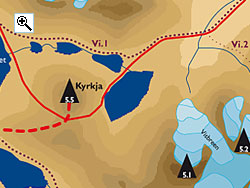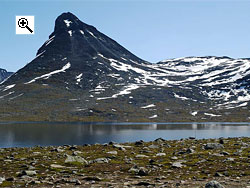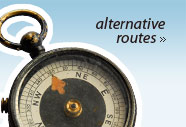Scandinavian Mountains over 2000 metres - James Baxter
Areas › Visbretind Massif › 5.5 Kyrkja (2032m)
Kyrkja, 2032m, is perhaps the most iconic mountain in Norway. It is not one of the giants by any means but its famous profile has made it one of the symbols of Jotunheimen. In addition to this it is situated in the geographical heart of Jotunheimen and the four streams draining each quadrant of its slopes are the birthplace of the four main rivers which drain each quadrant of central Jotunheimen. Its close proximity to Leirvassbu lodge make it very accessible and it slightly challenging ascent makes it very good value for effort.
| The Route from Leirvassbu Cabin | |
|---|---|
      |
|
From Leirvassbu lodge take the locked track, Ra.2, towards Gjendebu lodge along the west side of Leirvatnet lake for a km. Then leave the track follow the same marked path up the west side of a small ridge for a km before you cross over the apex of the ridge and descend the short east side to reach the Høgvaglen saddle.
 At this saddle leave the marked path and start to head up the interesting and pleasant ridge to the east. This ridge is composed of slabby outcrops and grassy shelves. After 1½ km, and before you get to the top of the hill 1843m. Contour round the north side of this hill at about 1750m elevation on increasingly big stones for ½ km to reach the saddle at 1755m.
At this saddle leave the marked path and start to head up the interesting and pleasant ridge to the east. This ridge is composed of slabby outcrops and grassy shelves. After 1½ km, and before you get to the top of the hill 1843m. Contour round the north side of this hill at about 1750m elevation on increasingly big stones for ½ km to reach the saddle at 1755m.
It is also possible to reach this saddle but going round the north, and then east of shore Leirvatnet lake for 2 km until you get to a stream. Cross this wide shallow stream by jumping from stone to stone and then start to head up the stony tundra slope towards the saddle for 2 km.
As you ascend up the slope the terrain becomes increasingly bouldery. This approach is perhaps a better descent route especially if there are still long snowfields. During the winter and spring season it is of course possible to ski straight over the lake and up the shallow valley of moderate incline to the reach saddle.
 From the saddle the route now goes up the south ridge. There are some cairns marking the path but even with the cairns it is barely perceptible as you clamber up, through and over rough scree to gain 100 meters height which is the first third of the climb from the saddle. There is often a snowfield on the eastern side of the ridge which might make the going easier, especially on the descent. This snowfield is steep however and an ice axe is essential.
From the saddle the route now goes up the south ridge. There are some cairns marking the path but even with the cairns it is barely perceptible as you clamber up, through and over rough scree to gain 100 meters height which is the first third of the climb from the saddle. There is often a snowfield on the eastern side of the ridge which might make the going easier, especially on the descent. This snowfield is steep however and an ice axe is essential.
The middle third of the ascent, again gaining 100 metres of height, is somewhat easier as the gradient eases slightly and the boulders are much smaller.
The final third, also with 100 metres of ascent, is the most exciting section. It starts with an easy grade II scramble up a 10 metre rock band. From the top of this rock band the ridge is a bit more pronounced and as you approach the top there are another couple of small steep scrambles but these are relatively easy and with little exposure.
This section in the winter and spring season is more demanding but should still prove feasible to experienced mountaineers with correct equipment.
The Descent
The descent can be by the same route. The other route mentioned in the second paragraph in this section is perhaps shorter, and if still covered in some snowfields, slightly easier. It also offers the added variation of a circular tour.

